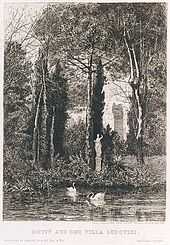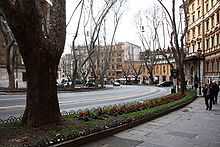Villa Ludovisi

The Villa Ludovisi was a suburban villa in Rome, built in the 17th century on the area once occupied by the Gardens of Sallust (Horti Sallustiani) near the Porta Salaria.[1] On an assemblage of vineyards purchased from Giovanni Antonio Orsini, Cardinal Francesco Maria Del Monte and others, Cardinal Ludovico Ludovisi erected in the 1620s the main villa building to designs by Domenichino; it was completed within thirty months, in part to house his collection of Roman antiquities,[2] additions to which were unearthed during construction at the site, which had figured among the great patrician pleasure grounds of Roman times. Modern works, most famously Gian Lorenzo Bernini's Pluto and Persephone, were also represented. The engraving of the grounds by Giovanni Battista Falda (1683)[3] shows a short access avenue from a tree-lined exedra in via di Porta Pinciana and cypress-lined avenues centered on each of the facades of the main villa, laid out through open fields, the main approaches to both the villa and the Casino dell'Aurora[4] converging on gates in the Aurelian Walls, which formed the northern bounds of the park; symmetrical parterres of conventional form including bosquets peopled with statuary[5] flanked the main avenue of the Casina, and there was an isolated sunken parterre, though these features were not integrated in a unified overall plan.[6] The overgrown avenues contrasting with the dramatic Roman walls inspired Stendhal to declare in 1828 that the Villa Ludovisi's gardens were among the most beautiful in the world.[7]
Frescoes in the villa were carried out by Domenichino, Guercino, Giovambattista Viola, and others. A casina was added, largely to house the Cardinal's growing collection of Roman sculptures and inscriptions, which Alessandro Algardi treated to sometimes extensive restoration.

The villa passed to the ownership of the Boncompagni Ludovisi family, which in 1872 rented it to King Victor Emmanuel II. The King used the villa as residence for his lover, Rosa Vercellana.[8]
İn 1885, despite great protests among the intellectuals, its last owner, Don Rodolfo Boncompagni Ludovisi, Prince of Piombino, sold the property to the Società Generale Immobiliare; it was divided into building lots.[9] The sculptures[10] were dispersed, and most of the buildings destroyed, the only one to remain being the Casino dell'Aurora. The Via Veneto was driven through its grounds, part of which are occupied by the American Embassy in Palazzo Margherita, and the Rione Ludovisi took shape, borrowing its district name from the cardinal and his villa.

Notes
- ↑ A. Schiavo, Villa Ludovisi e Palazzo Margherita, Rome 1981; I. Belli Barsale, Ville di Roma, Milan 1970, vol. III.1; D.R. Coffin, Gardens and Gardening in Papal Rome, Princeton 1991;
- ↑ Inventories of Villa Ludovisi have been partly published: paintings inventory of 1623 (C.H. Wood, "The Ludovisi Collection of Paintings in 1623" The Burlington Magazine, 1992) and of 1633 (K. Garas, "The Ludovisi Collection of Pictures in 1633" The Burlington Magazine, pt. I, ; pt. II, 1967).
- ↑ The engraving is illustrated in Eva-Bettina Krems, "Die 'magnifica modestia' der Ludovisi auf dem Monte Pincio in Rom." Marburger Jahrbuch für Kunstwissenschaft 29 (2002:105-163) p. 107, fig. 2.
- ↑ Named for Guercino's ceiling fresco of Aurora
- ↑ M.P. fritz, "Der statuenhain in den Gärten der Villa Ludovisi", Daidalos 65 (1997:42-51).
- ↑ The name of the French garden designer André Le Nôtre became optimistically associated with Villa Ludovisi in the 19th century (as in Th. Schreiber, Die antiken Bildwerke der Villa Ludovisi, Rome 1880, p. 5).
- ↑ Stendhal, Promenades dans Rome (18 April 1828), in Voyages en Italie.
- ↑ Her temporary absence permitted Henry james to inspect the villa and its grounds and indulge in some snobbish daydreams: on-line text.
- ↑ The Boncompagni Ludovisi financial crisis of 1893-96 is analysed in S. Palermo, Terra, città, finanza. I Boncompagni Ludovisi di Roma (1841-1896), 2008.
- ↑ The sculptures had been described by Th. Schreiber, Die antiken Bildwerke der Villa Ludovisi, Rome 1880.